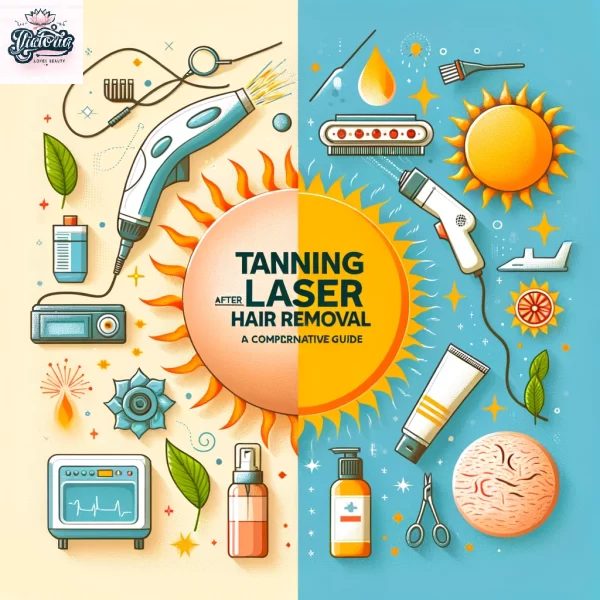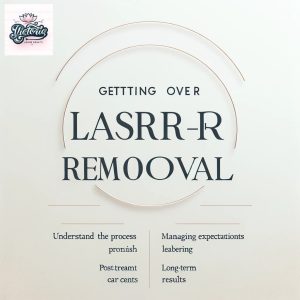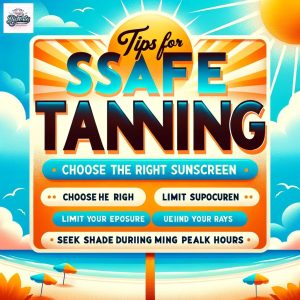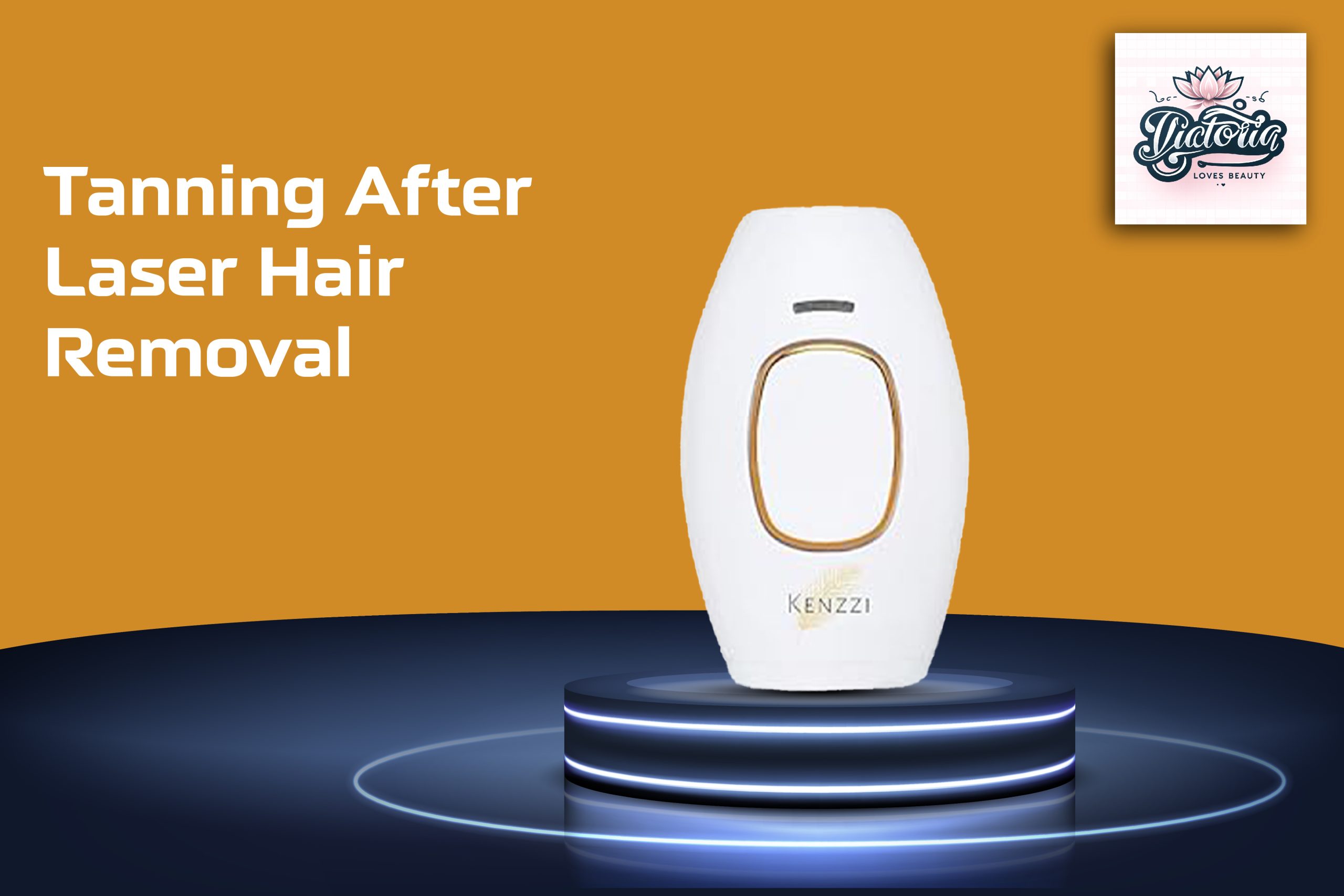In recent years, laser hair removal has become incredibly popular. While there is no denying the advantages of laser hair removal, it’s just as crucial to understand the aftercare to guarantee the best possible outcomes. The impact of tanning on the regions that are treated is an essential factor to take into account. After laser hair removal, exposure to sunlight or artificial tanning techniques may negatively affect the skin, resulting in skin discoloration or burns.
Why Is Sun Exposure a Concern?
After laser hair removal, sun exposure becomes problematic since the process leaves your skin more delicate and fragile. Concentrated light energy is aimed at the hair follicles during laser hair removal, which may cause tiny wounds or irritate the skin’s surface. Your skin can react by being red, bloated, or even breaking out in a transient heat rash just after the procedure. Even if they are transient, these symptoms indicate that your skin is fragile.

Using tanning beds or exposing recently treated skin to the sun’s UV radiation increases the risk of the following possible issues:
- Burns: Even at reduced sun exposure levels or in tanning beds, skin with laser treatment is more vulnerable to UV radiation burning. This may result in excruciating blisters and burns.
- Hyperpigmentation: Exposure to sunlight might cause the treated regions’ melanin to be overproduced, which can cause the pigmentation to darken or become uneven. Hyperpigmentation is the term for this disorder, which can be challenging to treat.
- Hypopigmentation: On the other hand, prolonged sun exposure can also result in hypopigmentation, which makes the treated regions momentarily lighter or devoid of pigment.
- Delay in Healing: UV rays can delay the skin’s healing process, which might make any pain or adverse effects after laser hair removal last longer.
The Risk of Tanning
The increased sensitivity of the treated skin to light following laser hair removal makes tanning more likely to result in skin problems, including hyperpigmentation, burns, and scars. Since your skin generates more melanin when it tans, the laser finds it more difficult to discriminate between skin and hair. The laser is primarily targeting melanin in hair follicles. Tanning can also interfere with the effectiveness of the treatment and cause unintended side effects. Also, to maximize outcomes and reduce the risk of skin damage after laser hair removal, limiting sun exposure, tanning beds, and unprotected sunbathing is imperative.
Guidelines for Sun Exposure
To preserve your skin and get the most outstanding results after laser hair removal, it’s essential to follow specific recommendations for sun exposure after the procedure:
- Avoid Direct Sunlight: It’s important to limit direct sun exposure to the regions that have had laser hair removal, especially in the first week following the procedure. If you must be outside, consider wearing protective gear such as long sleeves, slacks, and a hat with a broad brim. These physical barriers can protect your skin from UV rays.
- Use High SPF Sunscreen: Treat treated areas and any other exposed skin with a broad-spectrum sunscreen with an SPF (Sun Protection Factor) of at least 30. Make sure the sunscreen protects from UVA and UVB radiation. Apply liberally and regularly according to the directions on the product to limit the risk of burns, hyperpigmentation, and other skin problems and to provide an extra shield against UV damage.
- If Sunburned: It is best to postpone your laser hair removal treatment until your skin has completely recovered if you become sunburned before your booked appointment. Due to the damaged state of sunburned skin, it is more susceptible to negative responses and consequences from laser radiation. Letting your skin heal for a safer and more successful laser hair removal procedure is essential.
Traveling to Hotter Climates
Let your clinic know if you’re planning a sunny getaway after your laser hair removal. They’ll offer helpful tips based on your treatment progress and holiday timing, ensuring your skin stays safe and your results last. It’s a simple step for a worry-free vacation!
Getting Over Leaser Hair Removal

Post-Treatment Care: Nurturing Your Skin for Optimal Results
- Proper post-treatment care is essential for the best laser hair removal results and to minimize complications.
- This guide explores immediate post-treatment precautions, mid-treatment considerations, and ongoing care.
Immediate Post-Treatment: Handling Sensitivity and Healing
- Immediately after laser hair removal, your skin is sensitive.
- Avoid sun exposure and follow your provider’s recommendations.
- Learn how to soothe redness or discomfort for a safe and effective recovery.
Mid-Treatment Considerations: Managing Tanning and Session Schedules
- If you are in the middle of laser hair removal sessions, you’ll face unique challenges related to tanning and treatment schedules.
- Adapt your session schedule to accommodate travel plans and minimize sun exposure.
- Maintain the integrity of your skin throughout the treatment process.
Post-Treatment Maintenance: Sustaining Your Results and Skin Health
- After completing laser hair removal sessions, focus on post-treatment maintenance.
- Protect your skin from the sun even after the last session.
- Use sunscreen, protective clothing, and skincare products to preserve results, prevent complications, and enjoy long-term benefits.
Tanning Beds and Self-Tanners
After laser hair removal, use of tanning beds and self-tanners should be done very carefully for the following reasons:
Tanning Beds: High UV radiation levels emitted by tanning beds can be highly damaging to the skin, especially after laser hair removal when it is still sensitive. Tanning bed exposure raises the risk of burns, skin injury, and consequences, including hyperpigmentation or scarring. To preserve the integrity of your skin and prevent any negative responses, it is highly recommended that you stay away from tanning beds entirely in the weeks after your treatment.
Self-tanners: Although they don’t expose your skin to UV rays as tanning beds do, self-tanners can nonetheless irritate skin that has just had treatment. When self-tanning solutions are used on regions of skin that have just received laser hair removal, they may induce skin irritation, redness, or pain due to their chemicals. It’s advisable to hold off on applying self-tanners for at least two weeks after treatment to give your skin time to heal completely and lower the chance of discomfort.
When Can You Safely Tan?
After laser hair removal, tanning is safe to consider. However, it’s usually recommended to wait at least two weeks. Some sources advise delaying treatment for up to six weeks to lower the chance of negative responses, particularly if the treated region is sunburned. To ensure you strike the right balance between achieving your desired tan and protecting the results and health of your skin after treatment, you must speak with your laser hair removal provider for specific advice. They can assess your situation, considering factors like your skin type and the treatment area.
Myths and Misconceptions
- Myth: Tanning Enhances the Results: One common misconception is that tanning after laser hair removal can improve the treatment’s effectiveness. In reality, tanning can compromise the procedure’s results and lead to skin issues, making it advisable to avoid sun exposure during recovery.
- Myth: Indoor Tanning is Safe: Some believe indoor tanning beds are a safe alternative to natural sunlight. However, tanning beds emit concentrated UV radiation that can be even more damaging to the skin, especially when it’s in a sensitive state post-laser hair removal.
- Myth: Self-Tanners are Harmless: While self-tanners don’t expose the skin to UV radiation, they are not without risks. Some people assume that self-tanning products are safe to use immediately after laser hair removal, which can lead to skin irritation, sensitivity, and potential complications.
- Myth: Darker Skin is Immune: There’s a misconception that individuals with darker skin tones are immune to the risks of tanning after laser hair removal. While darker skin may have more natural protection against UV damage, it is not entirely immune, and precautions should still be taken to avoid potential complications.
- Myth: Tanning Accelerates Hair Growth: Contrary to popular belief, tanning does not stimulate regrowth after laser hair removal. Laser hair removal targets hair follicles; tanning does not impact this process. However, tanning can negatively affect the skin in other ways post-treatment.
Tips for Safe Tanning

- Wait for the Perfect Moment: Patience is essential when tanning following laser hair removal. Although it’s typically advised to wait at least two weeks before attempting any tanning, it’s essential to get specific instructions from your laser hair removal specialist. Waiting lowers the chance of problems and lets your skin repair.
- Steer clear of Direct Sunlight: Direct sunlight can harm sensitive skin, particularly in the early post-treatment phase. If you must be outside, cover up with skin-covering apparel such as long sleeves and wide-brimmed caps to protect treated regions. When you can, find shade.
- Use High SPF Sunscreen: Before going outside, cover all exposed skin, including treated areas, with a broad-spectrum sunscreen that has an SPF of at least thirty. Regularly reapply sunscreen, particularly if you’re perspiring or swimming. Sunscreen serves as an essential shield against UV rays that can be hazardous.
- Products for Sunless Tanning: As a safer substitute for tanning beds or the open sun, consider utilizing lotions, creams, or sprays that provide a sunless tan. Using these products, you may tan your skin without subjecting it to dangerous UV radiation. To make sure your skin has fully healed, wait at least two weeks after treatment before using them.
- Gradual Exposure: If you’re serious about tanning naturally, begin with brief, supervised sun exposure. Gradually increase your time in the sun while watching how your skin responds. This method reduces the chance of sunburn and overexposure.
- Hydration: Staying adequately hydrated is crucial for your general well-being as well as the resilience of your skin. Staying hydrated with lots of water will improve your skin’s healing process after laser hair removal and shield it from the sun’s rays.
Things to Remember
- Avoid Excessive Heat: Aside from tanning, avoid activities that generate excessive heat on treated areas, such as hot baths, saunas, or rigorous exercise, for a few days after each session.
- Watch for Allergic Reactions: Pay attention to your skin for any signs of allergic reactions to skincare products or sunscreen. If you notice redness, itching, or discomfort, discontinue use and consult your provider.
- Plan for Trips: If you have travel plans during your laser hair removal treatment, discuss them with your provider early to make necessary adjustments to your session schedule.
- Track Your Progress: Keep track of your hair regrowth patterns and any changes in the treated areas. This information can be valuable for your provider to fine-tune your treatment plan.
- No Plucking or Waxing: Avoid plucking, waxing, or any other hair removal methods that remove hair at the root between sessions, as this can interfere with the effectiveness of laser treatment.
Final Thoughts
- Optimal Laser Hair Removal Results: Proper post-treatment care is crucial for achieving the best results and minimizing complications.
- Immediate Aftercare: Right after a session, your skin is sensitive. Avoid sun exposure and follow your provider’s advice to recover safely.
- Mid-Treatment Considerations: If you’re in the middle of your laser hair removal sessions, manage tanning and treatment schedules wisely to protect your skin.
- Long-term Skin Health: After completing sessions, continue protecting your skin from the sun. Use sunscreen, wear protective clothing, and maintain a skincare routine for smooth, hair-free skin.
- Be Patient: Achieving the desired results takes time and patience. Rushing the process can lead to complications.
- Avoid Tanning Beds: Tanning beds emit harmful UV radiation; steer clear of them to protect your skin.
- Sunless Tanning Products: Consider using self-tanning lotions or sprays as a safer alternative to sun or tanning beds for achieving a tan.
- Hydration is Key: Drinking plenty of water helps keep your skin hydrated and supports healing.

Beauty enthusiast, mom on-the-go, and coffee addict (not necessarily in that order!). When she’s not chasing after her adorable toddler, Victoria is busy researching the latest beauty trends, testing out products, and sharing her discoveries with the world. Join her on this journey of self-care, empowerment, and finding your own unique spark of beauty!
